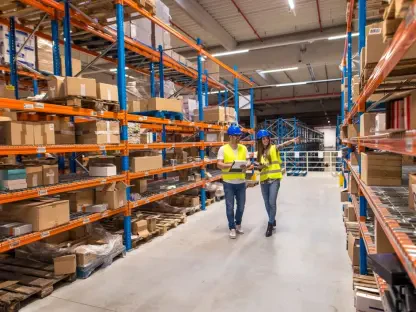Logistics and distribution centers are the backbone of the modern consumer economy, and safeguarding these facilities is a critical task. With innumerable products and thousands of employees, preventing loss without hampering operations is a significant challenge. This is where millimeter wave scanners come into play, marking an evolution in security screening technology.
The Core Challenges in Logistics Security
High Volume and Complexity
Logistics centers, like those of Amazon, deal with massive amounts of products and several thousand employees. The sheer scale introduces vulnerabilities such as employee theft, pilferage of raw materials, and unauthorized access to sensitive areas. The primary challenge is ensuring comprehensive security without creating bottlenecks. Traditional airport-style screening methods are ineffective due to their time-consuming nature, making them impractical for high-volume settings. This inefficiency can lead to significant operational delays, increased costs, and employee dissatisfaction.
Moreover, the scale of operations in these centers can make monitoring and accountability overwhelming. Thousands of employees working in shifts handling countless items render manual or conventional checks both impractical and unreliable. Any delay or interruption in workflow can disrupt the supply chain and impact customer satisfaction. Hence, there is a need for a security solution that is fast, comprehensive, and non-invasive, ensuring smooth operations and effective loss prevention.
Deterring Theft and Protecting Assets
Loss prevention in logistics centers goes beyond protecting tangible products. Intellectual property, proprietary data, and tools also need safeguarding. A robust security protocol must address the risk of employees smuggling out items like small electronics, sensitive documents, and even small storage devices. Conventional security solutions often fall short in detecting non-metallic objects such as plastics, ceramics, and liquids, which can also be significant sources of loss. The complexity of modern logistics operations requires a more nuanced and sophisticated solution.
In an environment where even small lapses can lead to significant losses, comprehensive threat detection is crucial. For example, employees might attempt to smuggle valuable items hidden under clothing or in personal effects. Traditional metal detectors might miss such items, especially if they are made of non-metallic substances. Therefore, a security solution that can detect a variety of materials and minimize false positives is necessary to maintain the integrity of operations without discouraging or inconveniencing employees.
Introducing Millimeter Wave Technology
Advanced Threat Detection
Millimeter wave scanners, particularly those introduced by companies like Rohde & Schwarz, offer a cutting-edge solution to logistical security challenges. These scanners can detect a broad range of objects, including non-metallic items, making them vastly superior in identifying potential threats. These scanners utilize non-ionizing, low-power radio waves, which provide a safe screening process for all individuals, including those with medical implants or pregnant employees. This feature ensures that health concerns are addressed without compromising security.
The essence of millimeter wave technology lies in its ability to generate high-resolution images that can reveal concealed items. Unlike conventional X-ray scanners, millimeter wave technology uses safe radiofrequency waves that reflect off the body to create a comprehensive image. This method ensures that all potential threats, regardless of their material composition, are identified quickly and accurately, thus enhancing the overall security framework while being non-invasive.
AI-Enhanced Precision and Efficiency
An essential advantage of modern millimeter wave scanners is their integration of AI-based machine learning algorithms. These algorithms can significantly improve the accuracy of threat detection, minimizing false positives and ensuring specific object recognition. Incorporating AI into the scanning process also means that personnel require minimal training to operate the devices efficiently. Moreover, AI can support unmanned operations, reducing the need for extensive staffing and decreasing operational costs.
The role of AI in millimeter wave scanners extends to analyzing behavioral patterns and improving the system’s adaptability. For instance, AI can learn from previous scans to better identify items that should trigger an alert. This continuous learning process enhances detection accuracy over time, ensuring that security measures evolve parallel to emerging threats. Consequently, implementing such advanced technologies contributes to a safer, more secure, and economically viable operation model, positioning millimeter wave scanners as a cornerstone of modern logistical security.
Operational Advantages
Throughput and Minimal Disruption
The Rohde & Schwarz QPS Walk2000 millimeter wave scanners, for instance, allow seamless screening without requiring employees to pause or remove clothing. This capability ensures a high throughput, capable of scanning up to 750 individuals per hour, suitable for managing peak shift changes without delays. By minimizing disruptions, these scanners help maintain a steady workflow, ensuring that productivity remains unaffected while enhancing security measures. This efficiency is crucial for facilities that cannot afford downtime during critical operations.
Efficiency in operational flow is paramount in logistics settings, where any delay can have a domino effect, hampering the entire supply chain. The ability to quickly and effectively scan large groups of employees ensures that the security process integrates seamlessly into the daily operations. Scanning employees without delay or discomfort not only boosts workforce morale but also underscores the company’s commitment to both security and employee well-being, making it a significant step forward in industrial security practices.
Cost-Effectiveness and Return on Investment
While the initial investment in millimeter wave scanners may seem substantial, the return on investment (ROI) is significant. Effective loss prevention translates to financial savings, continuity of operations, and maintained employee morale. Reducing theft and loss not only saves money but also boosts trust within the workforce. Employees are more likely to feel secure in a well-protected environment, enhancing their overall satisfaction and productivity. These factors collectively justify the expenditure on advanced security technologies.
Moreover, the longer-term benefits, such as reduced insurance premiums, lower shrinkage rates, and enhanced reputational integrity, further improve the financial outlook. Investing in such sophisticated loss prevention tools can mitigate risks that otherwise translate into sizable financial losses. The ROI extends beyond direct financial gains to include strengthened business resilience, loyalty from clients and partners who value robust security measures, and a competitive edge in high-stakes industries.
Practical Applications Across Industries
Diverse Use Cases
Though primarily touted for logistics centers, the utility of millimeter wave scanners extends across various industries. Data centers, pharmaceutical companies, and even military facilities can benefit from this technology, addressing unique security challenges effectively. For example, in the meat production industry, these scanners can detect attempts to smuggle meat products. Similarly, electronics firms can prevent data theft, ensuring that storage devices are not illegally removed from secured areas.
While these scenarios demonstrate the adaptability of millimeter wave technology, they also illustrate the technology’s broader application beyond traditional logistics settings. The ability to detect a range of non-metallic materials makes it highly valuable in settings where typical metal detectors would be ineffective. Thus, industries dealing with specialized or highly sensitive materials find millimeter wave scanners instrumental in maintaining security protocols without disrupting their specific operational requirements.
Ensuring Compliance and Safety
Logistics and distribution centers are a cornerstone of today’s consumer economy, handling the flow of goods and ensuring timely deliveries. These massive hubs house countless products and employ thousands of workers, making security a top priority. The challenge lies in preventing theft and loss without disrupting daily operations. Traditional security measures often fall short, leading to the need for advanced solutions.
Enter millimeter wave scanners. These devices represent a significant leap forward in security screening technology. They use high-frequency radio waves to create detailed, real-time images of concealed items, offering a non-invasive method to scan both people and packages quickly and efficiently. Unlike older technologies, millimeter wave scanners maintain the flow of operations while enhancing security measures. As a result, they streamline the prevention of unauthorized access and theft, making them invaluable for maintaining the integrity of logistics and distribution centers. This not only protects valuable assets but also creates a safer and more efficient working environment for employees.









